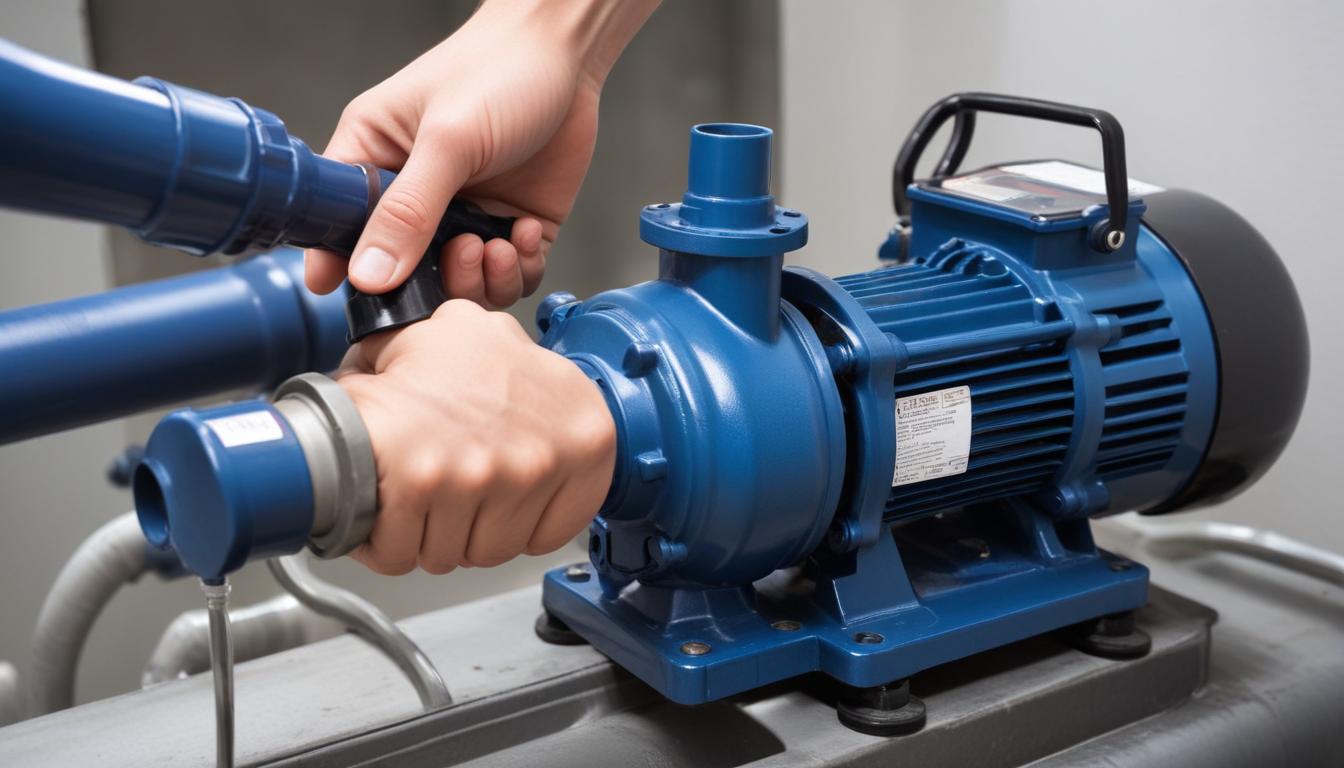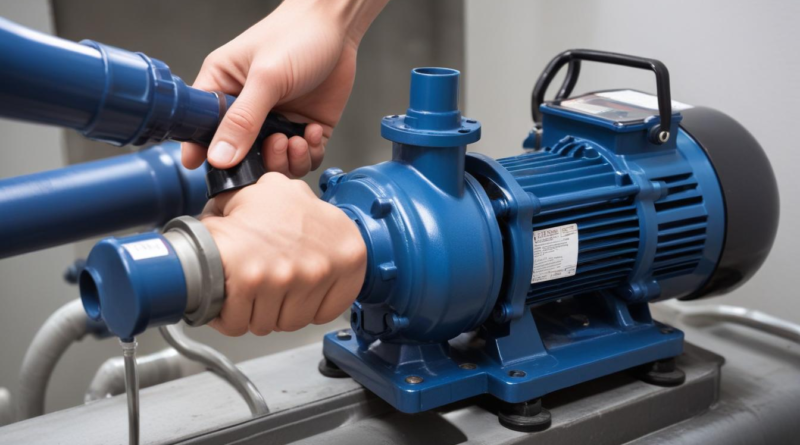how to monitor pump health
Pumps are essential components in numerous industrial and residential applications, responsible for moving fluids from one location to another. Understanding the fundamental aspects of pump operation is crucial for effective pump health monitoring and maintenance. At the core, a pump consists of several key components:
| Component | Function |
|---|---|
| Impeller | Generates flow by transferring energy from the pump shaft to the fluid. |
| Shaft | Connects the impeller to the motor, allowing rotational movement. |
| Casings | Directs the flow of fluid and maintains pressure conditions. |
| Bearings | Support the shaft and reduce friction during operation. |
| Seals | Prevent fluid leakage along the shaft. |
The operation of a pump can be understood through the following steps:
- Fluid Intake: Fluid enters the pump through the inlet port into the impeller.
- Energy Transfer: The motor rotates the shaft, causing the impeller to spin and impart energy to the fluid.
- Fluid Discharge: Energized fluid is expelled through the discharge port, creating flow and pressure.
Key factors influencing pump performance include:
- Flow Rate: The volume of fluid moved per unit time.
- Head Pressure: The height to which the pump can raise the fluid.
- Efficiency: The ratio of useful power output to the total power input.
- Viscosity: The thickness and internal friction of the fluid being pumped.
Understanding these operational principles and components is essential for diagnosing issues and implementing effective pump health monitoring techniques. Regular inspection and knowledge of how each part functions contribute to maintaining optimal pump performance and longevity.
key performance indicators
Effective pump health monitoring relies heavily on tracking specific key performance indicators (KPIs) that provide insights into the pump’s operational status and efficiency. By regularly assessing these indicators, maintenance teams can detect potential issues early, ensure optimal performance, and extend the lifespan of the pump. The primary KPIs to monitor include:
| Key Performance Indicator | Description | Significance |
|---|---|---|
| Flow Rate | The volume of fluid moved by the pump per unit time, typically measured in gallons per minute (GPM) or liters per second (L/s). | Indicates the pump’s ability to meet system demand. Deviations from the standard flow rate can signal blockages, leaks, or impeller wear. |
| Head Pressure | The height to which the pump can raise the fluid, measured in feet or meters. | Reflects the pump’s performance against the system’s pressure requirements. Lower than expected head pressure may indicate cavitation or impeller damage. |
| Efficiency | The ratio of useful power output to the total power input, expressed as a percentage. | High efficiency signifies optimal energy usage, while decreasing efficiency can highlight issues such as wear, misalignment, or air entrainment. |
| Vibration Levels | The measurement of oscillations or movements in the pump structure during operation. | Excessive vibrations can lead to mechanical failures. Monitoring helps in early detection of imbalances, misalignments, or bearing wear. |
| Temperature | The operating temperature of the pump’s components, especially the bearings and motor. | Abnormally high temperatures may indicate inadequate lubrication, overloading, or electrical issues, which can lead to premature failure. |
| Power Consumption | The amount of electrical power consumed by the pump, typically measured in kilowatts (kW). | Tracking power usage helps in identifying inefficiencies and ensuring the pump operates within its designed power range. |
In addition to these KPIs, it is essential to consider the following factors for comprehensive pump health monitoring:
- Operational Data Consistency: Ensuring that data collected over time remains consistent allows for accurate trend analysis and more reliable predictive maintenance.
- Baseline Establishment: Establishing baseline performance metrics under normal operating conditions is crucial for identifying deviations that may indicate potential issues.
- Alarm Thresholds: Setting appropriate thresholds for each KPI helps in triggering timely alerts when parameters exceed safe operating limits.
Implementing these key performance indicators as part of a robust pump health monitoring system enables proactive maintenance strategies. Utilizing advanced tools and techniques, such as real-time data analytics, remote monitoring sensors, and automated reporting, enhances the ability to maintain pump performance and prevent unexpected downtimes. Regularly reviewing and analyzing these indicators ensures that pumps operate efficiently, safely, and reliably within their intended applications.
monitoring techniques and tools
Effective pump health monitoring relies on a combination of advanced techniques and reliable tools to accurately assess the condition and performance of pumps. By leveraging these methods, maintenance teams can detect anomalies, predict potential failures, and ensure continuous optimal operation. The following are key techniques and tools commonly used in monitoring pump health:
Sensor-Based Monitoring
Utilizing various sensors provides real-time data on critical parameters, enabling continuous assessment of pump performance.
- Vibration Sensors: Detect imbalances, misalignments, and bearing wear by measuring oscillations in the pump structure.
- Temperature Sensors: Monitor the operating temperature of bearings and motor components to identify overheating issues.
- Flow Meters: Measure the flow rate of the fluid, ensuring it remains within desired parameters.
- Pressure Sensors: Track head pressure to verify that the pump meets pressure requirements.
Infrared Thermography
Infrared cameras capture thermal images of the pump and its components, identifying hotspots that may indicate electrical issues, mechanical friction, or inadequate lubrication.
Ultrasonic Testing
This technique uses high-frequency sound waves to detect leaks, cavitation, and mechanical wear. Ultrasonic sensors can identify issues that are not visible to the naked eye, providing early warning signs of potential failures.
Oil Analysis
Regular analysis of the pump’s lubrication oil can reveal contamination, degradation, and the presence of wear particles. This information helps in assessing the condition of bearings and other moving parts.
Acoustic Emission Monitoring
By listening to the sounds emitted by a pump during operation, this technique can detect abnormal noises that may signal issues such as cavitation, bearing defects, or impeller wear.
Remote Monitoring Systems
These systems provide the capability to monitor pump health from a centralized location, enabling real-time data access and management. Features often include:
- Wireless Connectivity: Facilitates data transmission from remote or hard-to-access pumps.
- Real-Time Alerts: Sends notifications when parameters exceed predetermined thresholds.
- Historical Data Analysis: Allows for trend analysis and performance benchmarking over time.
Supervisory Control and Data Acquisition (SCADA) Systems
SCADA systems integrate various monitoring tools and sensors, providing a comprehensive platform for controlling and analyzing pump operations. Key functionalities include:
- Data Visualization: Graphical interfaces display real-time data and historical trends.
- Automated Reporting: Generates reports on pump performance and health metrics.
- Remote Control: Enables operators to adjust pump settings and respond to alerts remotely.
Condition Monitoring Software
Specialized software applications analyze data collected from various sensors and monitoring tools, offering insights into pump health and performance. Features typically include:
| Feature | Description |
|---|---|
| Data Integration | Combines data from multiple sources for comprehensive analysis. |
| Predictive Analytics | Uses algorithms to forecast potential failures based on current trends. |
| Dashboard Interfaces | Provides user-friendly visual representations of key metrics and alerts. |
| Maintenance Scheduling | Assists in planning maintenance activities based on data-driven insights. |
Implementation Considerations
When selecting monitoring techniques and tools, several factors should be taken into account to ensure effective pump health monitoring:
- Compatibility: Ensure that the chosen tools are compatible with existing pump systems and infrastructure.
- Scalability: Select solutions that can scale with the growth of operations and the addition of more pumps.
- Ease of Use: Opt for user-friendly tools that require minimal training for maintenance personnel.
- Cost-Effectiveness: Balance the initial investment with the long-term benefits of improved pump reliability and reduced downtime.
By integrating these techniques and tools into a cohesive pump health monitoring strategy, organizations can enhance the reliability, efficiency, and longevity of their pumping systems. Continuous monitoring not only helps in early detection of issues but also supports informed decision-making for maintenance and operational improvements.
predictive maintenance strategies
 Predictive maintenance strategies leverage data-driven insights to anticipate and address potential issues before they lead to pump failures. By utilizing various techniques and tools, organizations can optimize maintenance schedules, reduce downtime, and extend the lifespan of their pumping systems. The following approaches are essential for implementing effective predictive maintenance:
Predictive maintenance strategies leverage data-driven insights to anticipate and address potential issues before they lead to pump failures. By utilizing various techniques and tools, organizations can optimize maintenance schedules, reduce downtime, and extend the lifespan of their pumping systems. The following approaches are essential for implementing effective predictive maintenance:
Data Collection and Analysis
Accurate and comprehensive data collection is the foundation of predictive maintenance. Key steps include:
- Real-Time Monitoring: Continuously collect data from sensors measuring parameters such as vibration, temperature, flow rate, and pressure.
- Historical Data Analysis: Analyze past performance data to identify patterns and trends that precede failures.
- Data Integration: Combine data from multiple sources, including SCADA systems, condition monitoring software, and manual inspections, to gain a holistic view of pump health.
Machine Learning and Predictive Analytics
Advanced predictive analytics and machine learning algorithms play a crucial role in forecasting potential failures by analyzing complex data sets:
| Technique | Description | Application |
|---|---|---|
| Regression Analysis | Identifies relationships between different performance metrics to predict future values. | Forecasting wear levels based on operational parameters. |
| Classification Algorithms | Categorizes data into predefined classes, such as normal operation or potential failure. | Detecting anomalies that may indicate imminent pump issues. |
| Time-Series Analysis | Analyzes data points collected or recorded at specific time intervals. | Predicting trends in flow rate or pressure changes over time. |
Condition-Based Maintenance
Condition-based maintenance (CBM) tailors maintenance activities based on the actual condition of the pump rather than on a fixed schedule. Key components include:
- Threshold Setting: Define acceptable ranges for critical KPIs. Maintenance is triggered when measurements exceed these thresholds.
- Continuous Assessment: Regularly evaluate pump conditions using real-time data to determine the necessity of maintenance activities.
- Resource Optimization: Allocate maintenance resources more efficiently by addressing only those pumps that require attention, thereby reducing unnecessary maintenance tasks.
Failure Mode and Effects Analysis (FMEA)
FMEA is a systematic method for identifying potential failure modes within a system and evaluating their impact on operations:
- Identify Failure Modes: List all possible ways in which pump components can fail.
- Assess Severity and Likelihood: Evaluate the potential impact and frequency of each failure mode.
- Prioritize Risks: Focus on addressing the most critical and likely failure modes to enhance pump reliability.
Predictive Maintenance Tools and Technologies
Several tools and technologies facilitate the implementation of predictive maintenance strategies:
| Tool/Technology | Function | Benefits |
|---|---|---|
| Condition Monitoring Systems | Continuously track and record pump performance data. | Provides real-time insights and enables prompt detection of anomalies. |
| Predictive Maintenance Software | Analyzes collected data using advanced algorithms to predict failures. | Facilitates data-driven decision-making and proactive maintenance planning. |
| IoT Devices | Enable remote data collection and connectivity for monitoring systems. | Enhances accessibility and scalability of pump health monitoring. |
| Cloud Computing Platforms | Store and process large volumes of pump performance data. | Offers flexibility and supports sophisticated data analytics applications. |
Implementation Steps for Predictive Maintenance
Successfully adopting predictive maintenance involves several key steps:
- Assess Current Maintenance Practices: Evaluate existing maintenance strategies to identify gaps and opportunities for improvement.
- Define Objectives: Set clear goals for what the predictive maintenance program aims to achieve, such as reducing downtime or extending pump lifespan.
- Select Appropriate Tools and Techniques: Choose the right combination of sensors, software, and analytical methods that align with the organization’s needs.
- Integrate Systems: Ensure that all monitoring tools and data collection systems are seamlessly integrated with existing infrastructure.
- Train Personnel: Provide training for maintenance staff on using new tools and interpreting data effectively.
- Continuous Improvement: Regularly review and refine predictive maintenance processes based on feedback and performance outcomes.
Benefits of Predictive Maintenance
Implementing predictive maintenance strategies offers numerous advantages:
- Reduced Downtime: Early detection of potential failures minimizes unexpected pump outages.
- Cost Savings: Preventing major failures reduces repair costs and extends the lifespan of pump components.
- Increased Efficiency: Optimizing maintenance schedules ensures that pumps operate at peak performance levels.
- Enhanced Safety: Proactively addressing pump issues mitigates the risk of accidents and hazardous situations.
- Data-Driven Decision Making: Access to comprehensive performance data enables more informed maintenance and operational decisions.
By adopting these predictive maintenance strategies, organizations can transform their approach to pump health monitoring. Leveraging advanced techniques and tools ensures that maintenance activities are proactive rather than reactive, ultimately enhancing the reliability, efficiency, and longevity of pumping systems.
troubleshooting common issues
Common issues with pump operation can significantly impact overall system performance and longevity. Identifying and addressing these problems promptly is essential for maintaining optimal functionality. The following are some prevalent challenges and strategies for troubleshooting them:
1. Reduced Flow Rate
A decrease in flow rate can disrupt system operations and indicate underlying issues. Potential causes and solutions include:
- Clogged Impeller: Debris or sediment accumulation can obstruct the impeller, reducing fluid movement.
- Solution: Regularly inspect and clean the impeller to ensure unobstructed flow.
- Leaky Seals: Damaged or worn seals may allow fluid to bypass the pump, diminishing flow.
- Solution: Replace faulty seals to restore proper fluid movement.
- System Leaks: External leaks in the piping system can decrease the effective flow rate.
- Solution: Conduct a thorough inspection of the piping and connections to identify and repair leaks.
- Incorrect Pump Sizing: An undersized pump may struggle to meet system demand.
- Solution: Reevaluate system requirements and select a pump with appropriate capacity.
2. Excessive Vibrations
Unusual vibrations can be symptomatic of mechanical issues that may lead to pump failure if not addressed:
| Cause | Possible Solution |
|---|---|
| Imbalanced Impeller | Rebalance or replace the impeller to eliminate imbalance. |
| Misaligned Shaft | Realign the pump and motor shafts to ensure proper alignment. |
| Worn Bearings | Inspect and replace worn or damaged bearings to reduce friction and vibration. |
| Loose Mountings | Tighten or secure pump mountings to minimize movement during operation. |
3. Overheating
Overheating can compromise pump components and lead to premature failure. Common causes include:
- Insufficient Lubrication: Lack of proper lubrication increases friction and heat generation.
- Solution: Ensure regular lubrication of bearings and moving parts as per manufacturer guidelines.
- Overloading: Operating the pump beyond its rated capacity can cause excessive heat.
- Solution: Adjust the system to operate within the pump’s specified limits or upgrade to a higher-capacity model.
- Electrical Issues: Problems with the motor, such as voltage fluctuations, can result in overheating.
- Solution: Inspect electrical connections and ensure the motor operates within its designed voltage range.
- Blocked Cooling Systems: Obstructions in cooling pathways can prevent proper heat dissipation.
- Solution: Clear any blockages and maintain clean cooling systems to facilitate effective heat removal.
4. Leaking Seals
Leakage can lead to fluid loss and potential damage to surrounding equipment. Common causes and remedies include:
- Worn or Damaged Seals: Seals degrade over time due to continuous exposure to fluids and operational stress.
- Solution: Regularly inspect seals and replace them when signs of wear or damage are evident.
- Improper Installation: Incorrect installation of seals can result in ineffective sealing.
- Solution: Follow manufacturer guidelines for seal installation and ensure proper alignment.
- Excessive Pressure: High system pressure can overwhelm seals, causing leaks.
- Solution: Monitor and regulate system pressure to stay within safe operational limits.
5. Unusual Noises
Abnormal sounds during pump operation can indicate various issues that require attention:
- Cavitation: Bubbles forming and collapsing within the pump create knocking or rattling noises.
- Solution: Adjust inlet pressure, ensure adequate NPSH (Net Positive Suction Head), and check for impeller wear to mitigate cavitation.
- Motor Issues: Electrical problems or motor defects can produce humming, buzzing, or grinding sounds.
- Solution: Inspect the motor for electrical faults, loose components, or bearing wear, and address any identified issues.
- Loose or Worn Components: Parts such as bolts, couplings, or bearings that are loose or worn can create grinding or squealing noises.
- Solution: Tighten or replace loose and worn components to eliminate unusual sounds.
6. Pump Not Starting or Running
Issues with pump startup or continuous operation can disrupt system functionality. Potential causes include:
- Electrical Failures: Faulty wiring, blown fuses, or motor issues can prevent the pump from starting.
- Solution: Check electrical connections, replace blown fuses, and test the motor for proper operation.
- Locked Rotor: Mechanical binding or excessive load can prevent the rotor from turning.
- Solution: Inspect for obstructions, reduce load, and ensure proper lubrication to allow the rotor to move freely.
- Control System Failures: Malfunctions in the control system can disrupt pump operation.
- Solution: Diagnose and repair issues within the control circuitry or programmable logic controllers (PLCs).
Implementing effective troubleshooting procedures as part of a comprehensive pump health monitoring program is vital for maintaining system reliability and performance. Utilizing advanced tools, such as vibration analyzers, thermal cameras, and diagnostic software, can enhance the accuracy and efficiency of identifying and resolving these common issues. Regular training for maintenance personnel and adherence to best practices further ensure that pumps operate smoothly and any disruptions are swiftly addressed.




